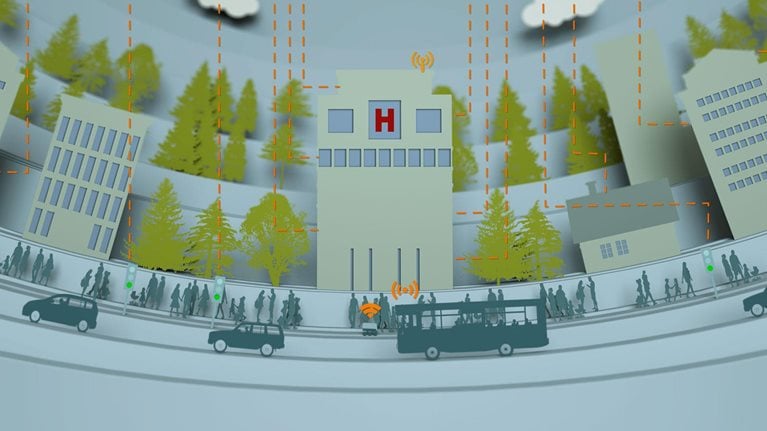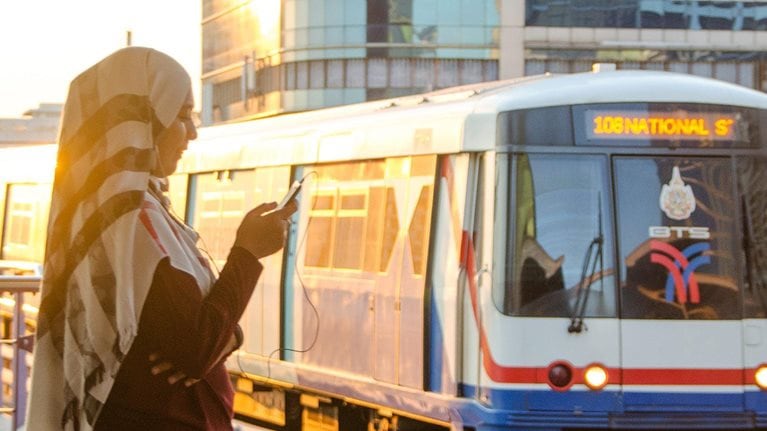The rapid urbanization of the world’s population is well under way. By 2050, 68 percent of the global population will live in urban areas.1 Emerging countries and regions will see the greatest increase in their urban populations, and China, India, and Nigeria represent slightly more than a third of the projected growth in that time frame.2 As city populations swell, municipal governments face increasing pressure from citizens and businesses to improve service delivery performance. Furthermore, the funding that municipalities receive from other government entities is decreasing. From 2010 to 2016, for example, central government funding as the share of total municipal revenue fell by approximately 12 percent, on average, across all countries in the Organisation for Economic Co-operation and Development (OECD)3 (Exhibit 1).

As a result of these twin trends, a majority of the municipalities around the world are struggling to increase revenues while facing structural budget shortfalls that threaten service delivery and quality. Beyond central government funding, the primary revenue streams for municipal governments are service fees, fines, taxes, and assets such as buildings and properties. And these sources tend to be far from optimized: local governments are often unaware of how to get more from existing sources and lack the resources to mount such efforts. In addition, elected officials must strike a tricky balance between raising taxes and fees and maintaining public support.
To meet rising expectations for service delivery amid tight budgets, municipal governments must increase revenues from existing sources as well as create new revenue streams. Elected officials have four primary revenue sources, each containing multiple levers. The challenge is identifying and prioritizing the opportunities that will have the greatest impact and are relatively feasible. In our experience, governments that pursue a practical approach to revenue generation can capture up to 50 percent of incremental revenues. This can be accomplished through moves that won’t adversely affect public opinion or a city’s competitiveness in attracting businesses and economic development.
Understanding municipal revenue streams
Before cities can begin to optimize their revenues, they must first compile an inventory of existing revenue streams. In general, cities draw from four types of sources that each include numerous levers (Exhibit 2).

Service fees. Municipalities raise revenues by charging for services such as public parking, toll roads, waste management, and building permits, among others.
Fines. Cities use fines as both a deterrent for behavior at odds with the public good—for example, the accumulation and nondisposal of garbage or building construction without a temporary fence—and a revenue source.
Charges and taxes. Municipalities often levy charges and taxes on property owners as well as on income, sales, and other transactions. These activities, such as hospitality charges and taxes on plastic bottles and bags, carbon from vehicles, and vacant land, do not involve the delivery of services from the government.
City assets and investments. Through leases, joint ventures, and joint development agreements, municipalities can generate additional income. Assets can include land monetization (such as land used by telcos for cell towers), appreciating land values, and commercial advertisements in public spaces, public markets, and shopping centers.
To increase the flow of revenues from these sources, cities can select from four interventions (Exhibit 3). Some are widely practiced, while others represent emerging and innovative options for city governments to pursue. Since residents often react negatively to actions that increase the cost of living, efforts to raise revenue through additional fees and taxes can be considered more acceptable when they also have a perceived public benefit. For instance, some cities have implemented a refundable deposit for beverage containers to encourage recycling or sought to enhance public safety by issuing speeding tickets to motorists.

1. Charge more
Perhaps the simplest and most straightforward approach across each of the four revenue streams would be to charge more. Municipalities could increase service fees (such as those on parking and construction permits) as well as fines, taxes, and the cost of accessing city assets (such as beaches). To guide price hikes, cities could use benchmarks to determine the acceptable range. This intervention is typically most applicable to service fees—specifically, utility services such as water, sewage, or electricity. As an alternative to benchmarking, cities could also determine the cost of services and then establish a cost-plus pricing model to generate additional revenues.
Would you like to learn more about our Public Sector Practice?
Cities could also revise their pricing models by using differentiating factors specific to each revenue lever. These factors often include volume of activity, location, and period of validity. In Finland, for example, fines for speeding are broadly linked to the income of violators and how far over the speed limit they were traveling when caught. This approach has the potential to not only fairly penalize offenders and reduce instances of speeding but also to generate more revenue. A 2016 study conducted by the Australia Institute concluded that the Finnish model would yield a 12 percent increase on average in the value of fines issued by five states in Australia.4
Last, municipalities could increase revenues by implementing higher fees for faster processing times or better service. This intervention is typically applicable to any paper-based transactions or services, such as business license fees, construction permit fees, or land registration fees. In Los Angeles, for instance, developers can obtain an expedited engineering permit for a surcharge of 40 percent of the permit’s cost.5
2. Increase number of transactions
Cities can also raise revenues by increasing the number of transactions through various approaches. This intervention includes expanding the sheer quantity of service offerings and assets, extending charges to a larger user base, or increasing the frequency of surveillance and inspection for selected fine sources to maximize detection of violations. Furthermore, technological advancements can aid increased surveillance. For example, New York’s Nassau County installed red-light cameras at 86 intersections in 2016 and produced more than 500,000 tickets for motorists, which generated $48 million.6 These cameras are controversial, and enhanced efficiency is one reason why many municipalities haven't taken this approach.
3. Improve collections
A third lever is optimizing collection and audit processes to increase collection rates and minimize leakage. One strategy that cities have followed is introducing an amnesty program for delinquent parking tickets that waives penalties and additional fines as an incentive for motorists to pay up. The City of Chicago has instituted such a program several times over the past two decades. Each time, the city brought in $7 million to $9 million in revenue.7 Other strategies, such as payment plans, can also reduce leakage and increase collections.
4. Create new revenue streams
Finally, cities could introduce new types of service fees, fines, and charges—and in so doing, create new sources of revenue. In general, this intervention represents the horizon for innovation across all revenue streams. For example, cities could institute new charges for the disposal of food waste. These fines would promote environmentally responsible behavior as well as create a viable revenue stream for the city. In 2013, Seoul introduced a volume-based food waste disposal charge that succeeded in reducing its daily food waste significantly.8 Similarly, London has instituted a congestion charge that drivers must pay when traveling within the city center. This charge generates more than $100 million in revenue each year.9
Optimizing land monetization has the potential to double baseline revenue from income-generating assets. For existing land lease contracts, cities could maximize value through renegotiation or cancellation and retender based on tenant response. When renegotiating existing leases, several levers can be utilized, such as increasing allowable floor-to-area ratio (FAR), collecting penalties for violations, amending contract duration and payment terms, and modifying plot use. Cities could also increase value from unused land plots through monetizing them either as lease contracts or through other more innovative public–private partnership structures, such as joint development agreements or joint ventures (Exhibit 4).

How to design a city revenue optimization strategy
Once cities have identified their field of options, they must consider several questions before jumping into implementation: Which streams and interventions can generate the most revenues with a limited impact on stakeholders? What is the size of the opportunity? And what is feasible to achieve? There is no one route that cities can or should take to boost revenues. Indeed, each city’s situation is inherently different and will require a unique combination of interventions and careful consideration to ensure the program is both economically and politically feasible.
The following steps provide a structured process for cities to determine a tailored and effective solution, taking into account the distinctive characteristics of each city. First, to identify the relevant revenue streams and which interventions to apply, cities should determine the relevant data and revenue baselines. This preparatory work generally consists of collecting the relevant data and developing the current revenue baseline. In addition, to help gauge the likelihood and tenor of social acceptance prior to forging ahead with implementation, cities could consider conducting a citizen sentiment survey to understand how receptive residents might be to specific changes in fee structures and charges.
Next, cities should perform a thorough gap analysis to define the potential revenue impact for any given stream. This exercise involves analyzing the city’s revenue baseline to determine current revenue generation across all streams and then comparing revenue streams against benchmarks for peer cities to identify any gaps. With initial adjustments for relevance and size of potential revenue impact, cities can select the most promising streams as revenue generators.
Following the clear identification of interventions and opportunities, cities can set priorities based on social acceptance, economic impact, and ease of implementation. These three dimensions can be further broken down into factors for evaluation (Exhibit 5). Cities should then establish a revenue committee that adopts a strategic perspective to assess the impact of revenue levers and understand the interlocking factors.

Social acceptance. How receptive citizens and businesses are to a given intervention in a revenue stream can have significant impact on the intervention’s long-term viability. Therefore, the following three areas should be examined:
- Visibility—the significance of the changes and their impact on citizens and businesses. Are changes concentrated within a specific group or area of the city or are they highly visible and applied to the entire population?
- Potential public benefit—the positive impact of the chosen revenue lever. Does the lever provide clear public benefit while inducing positive behavior? Are these interventions applied fairly to various socioeconomic segments?
- Price against benchmarks—a comparison of current prices for government services against data from comparable cities that have similar levels of competitiveness. Is the level of fees, fines, or charges higher or lower than the regional average?
In addition, the city should refer back to the results of the citizen sentiment survey conducted during the preparatory stage to help inform the assessment of social acceptance.
Impact on economy. Of course, feasibility depends in part on the impact of an action on the city and its residents. Areas to be assessed may include the following metrics:
- GDP—whether the lever impacts the economic sectors and activity in the city.
- Inflation—whether the lever increases the cost of living for residents.
- Competitiveness—the city’s position on various competitiveness indexes and how certain factors, such as government services and safety, compare with other urban centers.
Ease of implementation. An effective assessment will analyze a given intervention’s technical feasibility and implementation. Cities should consider the following areas:
- Technical readiness—the familiarity of the municipality with the technical requirements behind the suggested revenue lever and its implementation.
- Resources requirements—the resources needed to implement the selected lever.
- Alignment with government agenda—the relevance and fit of the suggested revenue lever when mapped across the government plan.
Collectively, these assessments will help cities to produce a prioritized list of levers for implementation.
Guiding principles for implementing revenue optimization programs
Fix the home. This category involves enhancing internal effectiveness of city teams to generate more revenues without visible impact to the public. In our experience, governments can capture significant value—up to 50 percent of potential additional revenues—by implementing measures linked to effectiveness such as enhancing collections and audit processes or better asset monetization.
Cover cost to serve where possible. Governments should ensure that fee levels cover the costs of services being provided in the majority of cases. This applies to administrative services as well as other city services such as utility provision.

Smart cities: Digital solutions for a more livable future
Introduce innovative fees and charges. Cities that want to implement new charges will be more likely to build public support if such measures both induce positive behavior and have a clear, equitable, and risk-averse public benefit. A new tax on plastic would raise revenues and also benefit the environment. VIP services can also be offered where increased fee levels guarantee higher quality. Los Angeles, for example, charges higher fees for expedited permitting and licensing processes.10
Bundle charges. A limited number of charges and taxes ensures higher social acceptance and minimal collection leakage. Dubai instituted a knowledge dirham, a flat charge that applies to all government services.11
How to implement the program
In our experience, cities that fare the best in their revenue generation efforts create an internal dedicated unit that is responsible for the strategy’s implementation. These cities typically adopt one of two archetypes: an independent revenue monetization department that focuses on commercial aspects and acts as a strategic unit for generating revenues, or a commercial unit integrated into the finance department that is responsible for tracking progress of revenue targets.
To establish this dedicated unit, cities could create a cross-functional workforce with representatives from different departments, including finance, planning, property, legislation, and key municipalities. This unit has several responsibilities. As such, it should have a seat on the revenue committee as well as the authority to define roles and responsibilities to track the revenue generated across different municipalities. It should also prepare reports on the performance of various initiatives and their respective owners or entities and update revenues studies based on changing market conditions. In Saudi Arabia, the Ministry of Municipal and Rural Affairs has a control unit that monitors the performance of regions and the regional government authorities that oversee municipalities. We have found that this effort has led to a year-over-year increase in municipal revenues of 30 percent.
To instill a culture of performance, organizations should set targets for net revenues and select key performance indicators (KPIs). For example, revenue KPIs could include the annual increase in revenue per lever, while nonrevenue KPIs could define targets for each lever and its corresponding interventions, such as the annual increase in the number of violations detected.
Performance meetings should be scheduled on a weekly basis to track revenue generation and build ownership. These meetings serve as a way to monitor progress and enable proper implementation. The involvement of leadership as well as all relevant departments and municipalities would help to ensure proper implementation across all levels.
Most cities have yet to unlock the full potential of their existing revenue sources, let alone tap into new streams. Despite the numerous options available to generate more funding for city operations, elected officials must proceed carefully. Maintaining public support is critical to the longer-term viability of such efforts, and cities must create an attractive business climate. Cities that successfully cultivate a mixture of actions can dramatically improve their fiscal health and improve services for their residents.


